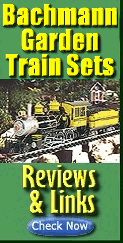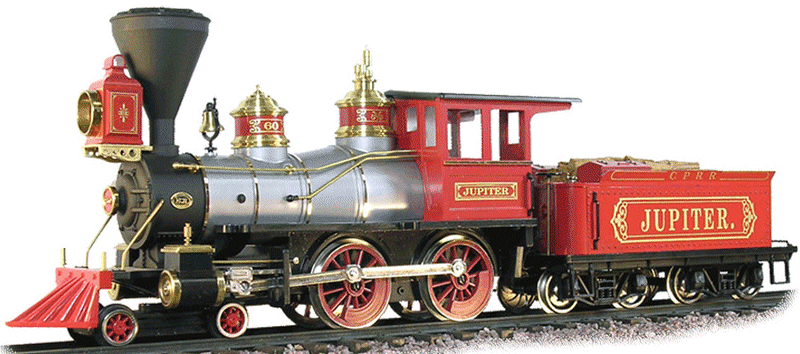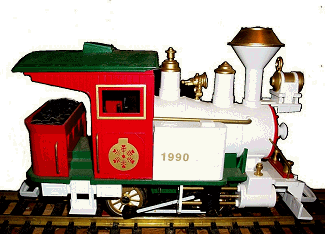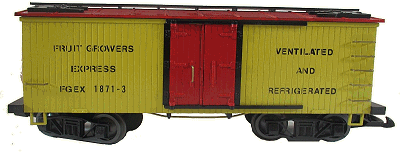 | |||
 |
 |  | |
 |  | ||
 |  | ||
 |  | ||
 |  | ||

| Please Read: How to Help Our Site at No Cost to You - Some of our articles contain recommendations for products we like and vendors we personally trust. Some of those vendors may pay us a very small commission if you click on a link and buy their products. This costs you nothing at all and helps offset the costs of what we do. So if we point you to something you decide to buy later, please make certain you come back through our site and click on the link directly. Thanks. |


 
|
Fallen Flags of Garden Railroading - KalamazooThis month's chapter is about an early US-based product line that did not last but which paved the way for more garden trains patterned after US prototypes, and some of whose individual products are still being produced by another US-based company.As you probably know, this is part of an intended series that will hopefully include several other notable brands. Note About Train Values: Whenever I post this sort of article, I start getting questions from people who have inherited old sets and want to know what they're worth. The short answer is that I don't know, but I know what you can do to find out for yourself. Check out the article "How Do I Sell My Train Collection?" for some tips. I have also posted an RSS feed of Kalamazoo train sets on eBay that may help you find out what sets like yours are going for. "Watch" the sets that look like yours and see what they actually sell for, not what people are asking. Some folks start out very low, but the sets wind up going for hundreds of dollars more than the first bid. Other folks post the set very high, and just keep relisting it because it never actually sells. When the sets actually change hands then you can start to establish a "price point." Modern Garden Railroading Started With Alpine TrainsLGB's initial offerings charmed thousands of North Americans, simply because they were, er, charming. Early adopters included "serious" model railroaders who liked the fact that - to Americans - most of the LGB products looked like toys. Not only did American customers like running trains outdoors; they also liked the fact that nobody was pressuring them to have everything exactly to scale, or historically accurate, or regionally appropriate.But seventeen years passed between the first LGB train and LGB's first serious attempt to make a train that looked North American (the Mogul, 1984/85). In that time, a number of Americans who had been perfectly satisfied to fill their back yards with Alpine trains and accessories began wishing that they had American-looking products. Kalamazoo Trains Were "Proud to Be an American"American Bob Schuster heard that frequently-expressed desire, and wanted to do something about it. Keep in mind that:
Bob made the choice to make a representative 4-4-0 with a wheelbase that was short enough to get around those tight LGB curves. In 1980, five years before the LGB Mogul emerged, Bob built a train which gave U.S. garden railroaders a choice that didn't look like it belonged in the Alps.
Bob's His trains were rugged and reliable, and they filled a need. Not only that, they (inadvertently, I'm sure) proved to Lehmann that there was a market for US-style trains. Toys or Models?Bob also called his company "Kalamazoo Toy Train Works." Why "toy" and not "model"? When these trains were being designed, Bob perceived his main competition to be the toy and toy-like first-generation LGB trains. Later manufacturers, including Delton Locomotive Works, who started out with expensive brass models, incorporated more details and more accurate proportions and called them models. But to most beginning garden railroaders at the time, there wasn't that much difference.  What About Scale?At the time, there were no established scale standards for North American garden trains trains. No one was making affordable trains that were in the correct scale for either US Narrow gauge (1:20.3) or US Standard gauge trains (1:32). I'm guessing that Bob figured that going somewhere in between (as Delton did, with their 1:24 trains, and AristoCraft did with their 1:29 trains) would be a reasonably safe compromise.I've since heard some of Kalamazoo's pieces described as 1:32 in scale and others described as 1:24 in scale. They tend to be smaller than the trains that followed them, Kalamazoo also made an 0-4-0T that pulled some of its smaller starter sets. It ran well enough, from what I've heard, and several friends still run theirs. When these were being made, there were some very nice paint jobs. I'm keeping my eye out for a better example, but this photo shows the profile, with a radial stay firebox that seems to have a large diameter compared to the rest of the boiler. This follows some actual prototypes, but it makes this particular boiler mold easy to spot in products from other manufacturers who inherited the molds later.
For a time, Kalamazoo kept the product line fresh by coming up with many different "paint jobs," including Christmas trains, Union and Southern-inspired Civil War trains, Rio Grand-inspired Bumblebee trains and more. Their printing also improved, as the silkscreened coach shows. After slightly more scale-oriented competitor, US-made Delton, went into bankruptcy, some of Delton's expertise and tooling went into improving Kalamazoo's 4-4-0. Nowadays used Kalamazoo locomotives turn up in many colors, with various levels of detail. If you had a choice between an earlier and later model, you'll probably prefer the later model, though I doubt you'd be disappointed with any of them, unless they've been abused. (The best versions of the Kalamazoo 4-4-0 are still being made in the USA by the Hartland Locomotive Works, HLW for short - see below).
Kalamazoo soon faced competition from American-looking LGB products like the Mogul, introduced 4-5 years after Kalamazoo's first trains. The Mogul was bigger and consequently more impressive that Kalamazoo's offerings, plus it sold well to folks who already had a big investment in LGB trains. But Kalamazoo faced even stronger competition when Bachmann's Chinese-built "Big Haulers" took over the low end of the market. There was no way they could match pricing with companies making cheaper products in cheaper places (like China).
The molds for the 4-4-0 and 0-4-0 and some cars went to Hartland Locomotive Works. Hartland kept the 0-4-0T alive for a time. Plus, parts of the 0-4-0T found their way into HLW's 2-4-4 "Forney" locomotive. Then, in 2015, Hartland reintroduced the 0-4-0t with several improvements as their 20th Anniversary Model HLW continued upgrading the 4-4-0's quality and still produces locomotives based on it today. Among other improvements, HLW replaces many of the pieces that were once plastic with metal pieces, especially brass. Plus there's a lot to be said for things like new motors and DCC-readiness. One current version of the 4-4-0, the Jupiter, is shown below. Click on the photo if you want to see this locomotive on Hartland's web page.  HLW has also upgraded several of Kalamazoo's freight cars. Desirability - Kalamazoo trains are a bit smaller than most other garden trains - except for those by Hartland Locomotive Works, who have, not only Kalamazoo's steamer molds, but also 1:24 molds from Delton Locomotive Works, another influential fallen flag. The relatively smaller sized, combined with the less-than-detailed appearance of the earlier products, kept them from being a favorite among the majority of garden railroaders. In the years since their demise, they have not acquired any particular "collectors's value," though they are still of interest to people who want solid trains they can run or who like a particular issue or "paint job." The short version is: if you see a set that runs and is in good condition, it's worth whatever you think it's worth to you. Also, if you really like the look of any Kalamazoo product, and you can't find one in good condition, check out HLW's collection - they may have a new, improved version of it available. Click here to return to the Fallen Flags of Garden Railroading index page. For More Information - Additional notes on Kalamazoo and the manufacturers its products eventually affected are included in David Fletcher's article The Phil Jenson Story. |
|
||
Note: Family Garden TrainsTM, Garden Train StoreTM, Big Christmas TrainsTM, BIG Indoor TrainsTM, and BIG Train StoreTM are trademarks of
Breakthrough Communications (btcomm.com). All information, data, text, and illustrations on this web site are
Copyright (c) 1999, 2000, 2001, 2002, 2003, 2004, 2005, 2006, 2007, 2008, 2009, 2010, 2011, 2012, 2013, 2014, 2015, 2016, 2017by
Paul D. Race. Reuse or republication without prior written permission is specifically
forbidden.
Family Garden Trains is a participant in the Amazon Services LLC Associates Program,
an affiliate advertising program designed to provide a means for sites to earn advertising
fees by advertising and linking to amazon.com.
For more information, please contact us
 |  |
| Visit related pages and affiliated sites: | |||||
| - Trains and Hobbies - | |||||
 |  |
 |
 |
 |  |
 |

|

|  |
 |

|
| - Christmas Memories and Collectibles - | |||||
 |

|
 |

|
 |

|
| - Family Activities and Crafts - | |||||
 |

|

|

|

|

|
| - Music - | |||||

|
 |
 |

|

|

|

|

|

|

|

|

|

|

|

|

|

|

|
 Bob's product line was named after their city of manufacture, Kalamazoo, Michigan. Interestingly enough, that city's manufacturing history includes the "Kalamazoo Railway Supply" company, which use to make human-powered track inspection vehicles called "velocipedes."
Bob's product line was named after their city of manufacture, Kalamazoo, Michigan. Interestingly enough, that city's manufacturing history includes the "Kalamazoo Railway Supply" company, which use to make human-powered track inspection vehicles called "velocipedes."





 I'm told that Kalamazoo sent a set to the White House during the Reagan administration. That story is told
I'm told that Kalamazoo sent a set to the White House during the Reagan administration. That story is told 